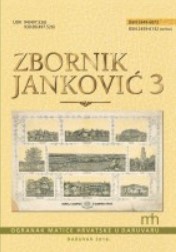KRONOLOGIJA GRADNJE I STILSKA OBILJEŽJA REPREZENTATIVNIH ARHITEKTONSKIH ZDANJA OBITELJI JANKOVIĆ U DARUVARU
THE CHRONOLOGY OF BUILDING AND STYLE CHARACTERISTICS OF REPRESENTATIVE ARCHITECTURAL ACCOMPLISHMENTS OF THE JANKOVIC FAMILY IN DARUVAR
Author(s): Staša PopadićSubject(s): Cultural history, Architecture, Local History / Microhistory, 18th Century, 19th Century
Published by: Matica hrvatska Daruvar
Keywords: Daruvar; family Janković; architecture;
Summary/Abstract: In a time span of one century and sixteen years (1763-1879), when family Janković govern these areas, Daruvar is rapidly urbanized. This paper brings the chronology and construction, as well as style characteristics of representative buildings that the family had built during their governance. The Janković family castle was built from 1771. to 1777. by the projects of unknown Viennese architects. Instead of decorative and architectural playfulness which is characteristic for the late Baroque period, on the facades of the castle we see a very calm and aristocratic expression. The origins of this toned down, monumental style we find in the Viennese architecture of the second half of the 18th century. The Altan that was constructed 1868.-1870. has classical elements that evoke antiquity, thus contributing to the castles uniqueness. The Church of the Most Holy Trinity, originally the Janković Palace Chapel, was built in 1764. It was remodeled on three occasions, but even though it had construction work done, it did not lose its initial dynamic Baroque design. Later renovations adorn the Church with a neo-Renaissance bell tower. The building represents one of the few central circular churches of this period, it is also the first example of a circular ground plan with a dome in the Baroque period in North of Croatia. Recognizing the potential of thermal springs, Antun Jankovic started building the bathing complex around 1762. on the remains of ancient thermal baths. The development of the complex continues throughout three generations of the Jankovics, and even after their departure from Daruvar in 1879. In this paper, I analyze the most representative buildings located in the southern part of the complex. Antun’s bath was built in 1762., and although architecturally very simple, the building stands out due to its history and neo-Gothic elements that evoke early Gothic expressions. Villa Arcadia was originally built in the Baroque style typical for these areas in the second half of the 18th century, but elements that speak of a Secession reconstruction can also be seen on the facades. Ivanova’s Bath was built in 1810-1818, and in its original phase we classify the building as one of the few very high-quality accomplishments of Classicism in Croatia. Today’s neo-Renaissance appearance is a result of remodeling done sometime between 1885 and 1909, and is visible in the elegant decorations of the facade. The Swiss Villa is interesting because it was built in a completely different style than the other buildings in the complex. We see an influence of alpine architecture in the shape of the wooden double porch and its decorations in the spirit of romanticism that flows through the Monarchy at that time. The Central Mud Bath was constructed on two occasions – sometime between 1862 and 1879, and again between 1908 and 1910. The original building had characteristics of romanticism inspired by alpine architecture. With its construction, the ornamental style of Hungarian Secession inspired by the Mauritius architecture found its place in Daruvar. All of the mentioned buildings still stand today and speak of a wealthy building history that the Jankovics started in these areas. Because of them Daruvar had been urbanized and from that point on known as a place of culture and health tourism.
Journal: Zbornik Janković
- Issue Year: III/2018
- Issue No: 3
- Page Range: 121-156
- Page Count: 36
- Language: Croatian

